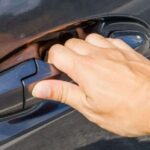Dealing with rust on your car, especially around the wheel arches, is a common issue for car owners, particularly with older vehicles. Rust not only looks unsightly but can also compromise the structural integrity of your car if left untreated. Repairing rust on a car wheel arch is a manageable DIY task that can save you money and prolong the life of your vehicle. This guide will walk you through the steps on how to effectively repair rust on your car’s wheel arches.
Identifying and Assessing Wheel Arch Rust
Before you start the repair process, it’s crucial to properly assess the extent of the rust damage. Wheel arches are particularly susceptible to rust due to their exposure to road debris, salt, and moisture. Start by cleaning the affected area to get a clear view of the rust. Surface rust is typically just on the outer layer of the metal and can be easier to repair. However, if the rust is deeper and has penetrated through the metal, it will require more extensive repair work, possibly involving cutting and welding.
DIY Rust Repair on a Car Wheel Arch: Step-by-Step
For minor to moderate rust on a wheel arch, you can often tackle the repair yourself. Here’s a step-by-step guide:
1. Gather Your Tools and Materials
You’ll need to gather the following:
- Safety Gear: Gloves, safety glasses, and a dust mask.
- Cleaning Supplies: Soap, water, and a sponge or cloth.
- Sanding Tools: Various grits of sandpaper (e.g., 80, 120, 240, 320), sanding block, and possibly a power sander for larger areas.
- Rust Removal Tools: Wire brush, rust converter or rust remover.
- Body Filler: Automotive body filler and applicator.
- Primer: Rust-inhibiting primer.
- Car Paint: Matching car paint and clear coat.
- Masking Tape and Paper: For protecting surrounding areas.
- Wax and Grease Remover: For cleaning before painting.
2. Prepare the Area
Start by thoroughly cleaning the wheel arch area with soap and water to remove any dirt and debris. Dry the area completely. Use masking tape and paper to protect the surrounding paintwork from sanding and filler.
3. Remove the Rust
Using a wire brush, remove as much loose rust as possible. For surface rust, sanding will be effective. Start with a coarser grit sandpaper (e.g., 80 grit) to remove the bulk of the rust. Work your way up to finer grits (e.g., 240, then 320) to smooth out the area. If using a power sander, be careful not to remove too much material and damage the surrounding good metal.
4. Apply Rust Converter
After removing the surface rust, apply a rust converter to chemically treat any remaining rust and prevent it from spreading. Follow the product instructions for application and drying time. Rust converter turns the rust into a stable compound, preparing the surface for filler.
5. Apply Body Filler
Once the rust converter is dry, mix your body filler according to the manufacturer’s instructions. Apply a thin layer of body filler to the damaged area using an applicator. Build up thin layers, allowing each layer to dry before applying the next. This helps to prevent air bubbles and ensures a stronger repair.
6. Sand the Body Filler
After the body filler is completely dry, begin sanding it to shape. Start with a coarser grit sandpaper (e.g., 120 grit) to remove excess filler and shape the repair to match the original wheel arch contour. Gradually move to finer grits (e.g., 240, 320) to smooth the surface and blend it with the surrounding area. Use a sanding block to ensure a flat and even surface.
7. Prime the Area
Clean the sanded area with wax and grease remover to remove any dust and contaminants. Apply several thin coats of rust-inhibiting primer to the repaired area, allowing each coat to dry properly. Primer helps to seal the body filler, prevent future rust, and provides a good base for the paint.
8. Paint and Clear Coat
After the primer is dry, lightly sand it with fine-grit sandpaper (e.g., 320 or 400 grit) to create a smooth surface for painting. Clean the area again with wax and grease remover. Apply several thin coats of your matching car paint, allowing each coat to dry. Once the color coat is dry, apply a few coats of clear coat to protect the paint and provide a glossy finish.
9. Final Polish
After the clear coat is fully cured (refer to paint instructions for drying times), you can use a polishing compound to buff out any imperfections and blend the newly painted area seamlessly with the surrounding original paintwork.
Professional Repair vs. DIY
While DIY repair is cost-effective for minor rust, severe rust damage, especially if it has penetrated the metal, might require professional attention. A professional body shop can perform more complex repairs, including welding in new metal sections and ensuring a factory-quality finish. If you are unsure about the extent of the rust or lack the tools and experience, it’s always best to consult with a professional.
Maintaining Your Wheel Arches to Prevent Rust
Prevention is always better than cure. Regularly washing your car, especially during winter months when salt is used on roads, can help prevent rust. Applying wax periodically can also add a protective layer to your car’s paint and wheel arches. Promptly addressing any stone chips or scratches can also prevent rust from starting.
Repairing rust on a car wheel arch is a rewarding DIY project that can improve the appearance and longevity of your car. By following these steps, you can effectively tackle rust and keep your vehicle looking its best for years to come.

